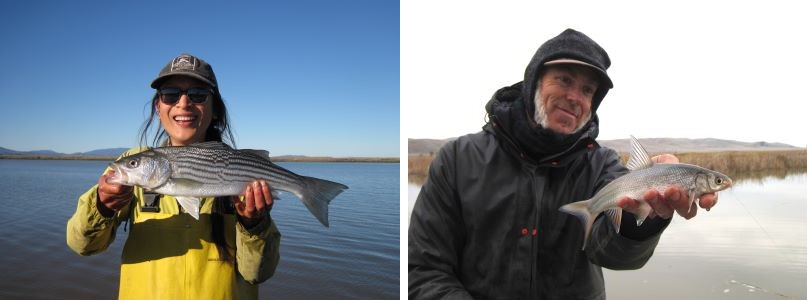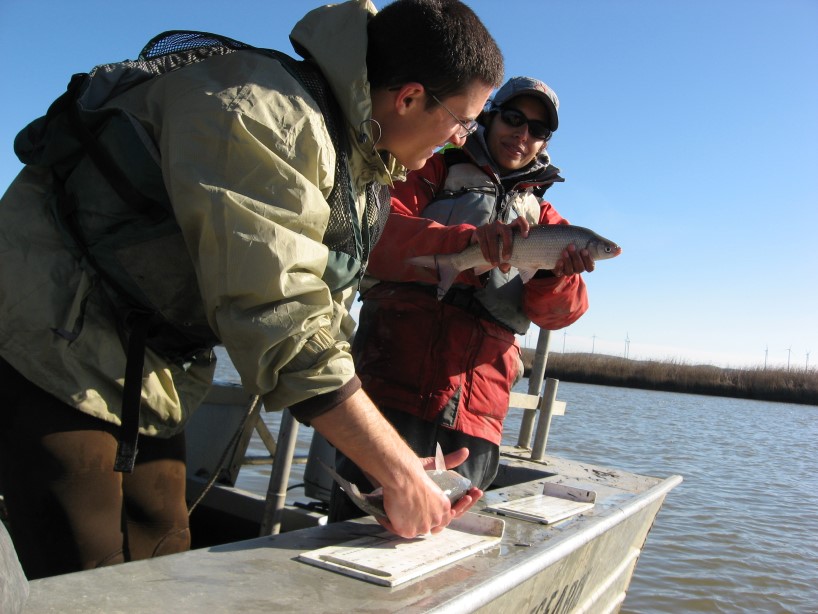Program Overview
The UC Davis Suisun Marsh Fish Study, in conjunction with the California Department of Water Resources (DWR) and numerous volunteers, monitors fish and invertebrate abundances in relation to changes in environmental conditions, both natural and human-made. The study is the backbone for more intensive studies on mechanisms contributing to broad-scale patterns. In recent years, the fish study has been complemented by other UC Davis research - on mammals, reptiles, and birds - to provide a more complete picture of the Suisun Marsh ecosystem. The primary goal of the Suisun Marsh Fish Study and associated projects is to provide information for improving management of Suisun Marsh for all life.
 The two dominant fish species of Suisun Marsh: striped bass (left, photo: Teejay O'Rear) and Sacramento splittail (right, photo: Brian Williamshen).
The two dominant fish species of Suisun Marsh: striped bass (left, photo: Teejay O'Rear) and Sacramento splittail (right, photo: Brian Williamshen).
History
- 1980: First year of standardized sampling, with 17 stations sampled consistently to the present
- 1994: Addition of four stations (in Denverton and Nurse sloughs) to standardized sampling
- 1994: Larval fish sampling for five years
- 2013: Expansion of the fish study’s methods to the North Delta
Methods
The study uses two primary methods for sampling fishes and invertebrates: beach seines and otter trawls. Samples are collected monthly at fixed sites, generally over three days, within subtidal sloughs of Suisun Marsh (Figure 1). Trawling is conducted using a four-seam otter trawl that is towed at 4 kilometers/hour for five minutes in small sloughs and at the same speed for 10 minutes in large sloughs. Inshore fishes are sampled with a 10-meter-wide bag-less beach seine on mud-bottomed beaches. For each site, water temperature, salinity, dissolved-oxygen concentration, water clarity, tidal stage, and water depths are recorded. Except for individuals destined for lab work, all fishes and larger invertebrates (e.g., clams, shrimps) are identified to species, measured for standard length if a fish, then immediately returned to the water (for more information on methods, see the report "Trends in Fish and Invertebrate Populations of Suisun Marsh January 2021 - December 2021").
 Processing the trawl catch. Photo by © Teejay O’Rear.
Processing the trawl catch. Photo by © Teejay O’Rear.
Notable Publications
- Aguilar-Medrano, R., J.R. Durand, V.H. Cruz-Escalona and P.B. Moyle. 2019. Fish functional groups in the San Francisco Estuary: understanding new fish assemblages in a highly altered estuarine ecosystem. Estuarine, Coastal and Shelf Science: 227106331
- Baumsteiger, J., R. Schroeter, T. O'Rear, J. Cook, and P. Moyle. 2017. Long-term surveys show invasive overbite clams (Potamocorbula amurensis) are spatially limited in Suisun Marsh, California. San Francisco Estuary and Watershed Science 15(2).
- Colombano, D., A.D. Manfree, T. O'Rear, J.R. Durand, and P. B. Moyle. 2020. Estuarine-terrestrial habitat gradients enhance nursery function for resident and transient fishes in the San Francisco Estuary. Marine Ecology Progress Series 637: 141-157.
- O'Rear, T.A., Moyle, P. B., & Durand, J. R. (2022). Trends in Fish and Invertebrate Populations of Suisun Marsh January 2021 - December 2021.
- Stompe, D.K., P. B. Moyle, A. Kruger, and J.R. Durand. 2020. Comparing and Integrating Fish Surveys in the San Francisco Estuary: Why Diverse Long-Term Monitoring Programs are Important. San Francisco Estuary and Watershed Science 18(2): Article 4.
Related Information